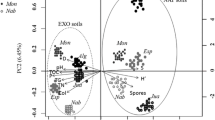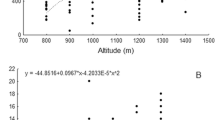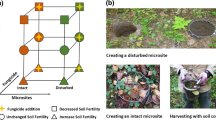Summary
The species composition of vesicular-arbuscular mycorrhizal (VAM) fungal communities changed during secondary succession of abandoned fields based on a field to forest chronosequence. Twenty-five VAM fungal species were identified. Seven species were clearly early successional and five species were clearly late successional. The total number of VAM fungal species did not increase with successional time, but diversity as measured by the Shannon-Wiener index tended to increase, primarily because the community became more even as a single species, Glomus aggregatum, became less dominant in the older sites. Diversity of the VAM fungal community was positively correlated with soil C and N. The density of VAM fungi, as measured by infectivity and total spore count, first increased with time since abandonment and then decreased in the late successional forest sites. Within 12 abandoned fields, VAM fungal density increased with increasing soil pH, H2O soluble soil C, and root biomass, but was inversely related to extractable soil P and percent cover of non-host plant species. The lower abundance of VAM fungi in the forest sites compared with the field sites agrees with the findings of other workers and corresponds with a shift in the dominant vegetation from herbaceous VAM hosts to woody ectomycorrhizal hosts.
Similar content being viewed by others
References
Abbott LK, Robson AD (1982) Infectivity of vesicular-arbuscular mycorrhizal fungi in agricultural soils. Aust J Agric Res 33:1049–1059
Allen EB, Allen MF (1980) Natural re-establishment of vesicular-arbuscular mycorrhizae following stripmine reclamation in Wyoming. J Appl Ecol 17:139–147
An Z-Q, Grove JH, Hendrix JW, Hershman DE, Henson GT (1990) Vertical distribution of Endogonaceous mycorrhizal fungi associated with soybean, as affected by soil fumigation. Soil Biol Biochem 22:715–719
Anderson RC, Liberta AE, Dickman LA (1984) Interaction of vascular plants and vesicular-arbuscular mycorrhizal fungi across a soil moisture-nutrient gradient. Oecologia 64:111–117
Benjamin PK, Anderson RC, Liberta AE (1989) Vesicular-arbuscular mycorrhizal ecology of little bluestem across a prairie-forest gradient. Can J Bot 67:2678–2685
Burford JR, Bremner JM (1975) Relationships between the denitrification capacities of soil and total, water-soluble and readily decomposable soil organic matter. Soil Biol Biochem 7:389–394
Carling DE, Brown MF, Brown RA (1979) Colonization rates and growth responses of soybean plants infected by vesicular-arbuscular mycorrhizal fungi. Can J Bot 57:1769–1772
Dahnke WC (1988) Recommended chemical soil test procedures for the north central region. Bull No 499. North Dakota State Univ Fargo, ND USA
Delaney BC (1988) Early stages of old-field succession in east-central Minnesota. M.S. Thesis, University of Minnesota, St. Paul, MN USA
Fresco LFM (1989) “Vegrow”: analyse van vegetatie-data. S-BEES, University of Groningen, Haren The Netherlands
Gardner JH, Malajczuk N (1985) Succession of ectomycorrhizal fungi associated with eucalypts on rehabilitated bauxite mines in south western Australia. In: Molina R (ed) Proceedings of the 6th North American Conference on Mycorrhizae. June, 1984. Oregon State University. p 265
Gerdemann JW, Nicolson TH (1963) Spores of mycorrhizal Endogone species extracted from soil by wet sieving and decanting. Trans Br Mycol Soc 46:235–244
Gibson DJ, Hetrick BAD (1988) Topographic and fire effects on the composition and abundance of VA-mycorrhizal fungi in tall-grass prairie. Mycologia 80:433–441
Giovannetti M, Mosse B (1980) An evaluation of techniques for measuring vesicular arbuscular mycorrhizal infection in roots. New Phytol 84:489–500
Gleeson SK, Tilman D (1990) Allocation and the transient dynamics of succession on poor soils. Ecology 71:1144–1155
Graham JH, Leonard RT, Menge JA (1981) Membrane-mediated decrease in root exudation responsible for phosphorus inhibition of vesicular-arbuscular mycorrhiza formation. Plant Physiol 68:548–552
Grigal DF, Chamberlain LM, Finney HR, Wroblewski DV, Gross ER (1974) Soils of the Cedar Creek Natural History Area. Univ. of Minnesota Agric Exp Sta Misc Report 123
Hall IR (1977) Species and mycorrhizal infections of New Zealand Endogonaceae. Trans Br Mycol Soc 68:341–356
Hayman DS (1982) Influence of soils and fertility on activity and survival of vesicular-arbuscular mycorrhizal fungi. Phytopathology 72:1119–1125
Hayman DS, Stovold GE (1979) Spore populations and infectivity of vesicular-arbuscular mycorrhizal fungi in New South Wales. Aust J Bot 27:227–233
Henkel TW, Smith WK, Christensen M (1989) Infectivity and effectivity of indigenous vesicular-arbuscular mycorrhizal fungi from contiguous soils in southwestern Wyoming, USA. New Phytol 112:205–214
Hoagland DR, Snyder WC (1933) Nutrition of strawberry plant under controlled conditions: (a) effects of deficiencies of boron and certain other elements: (b) susceptibility to injury from sodium salts. Proc Am Soc Hort Sci 30:288–294
Inouye RS, Huntly NJ, Tilman D, Tester JR, Stillwell M, Zinnel KC (1987) Old-field succession on a Minnesota sand plain. Ecology 68:12–26
Janos DP (1980) Mycorrhizae influence tropical succession. Biotropica 12:56–64 (Tropical Succession)
Johnson NC, Pfleger FL, Crookston RK, Simmons SR, Copeland PJ (1991) Vesicular-arbuscular mycorrhizas respond to corn and soybean cropping history. New Phytol in press
Koske RE, Walker C (1985) Species of Gigaspora (Endogonaceae) with roughened outer walls. Mycologia 77:702–720
Krebs CJ (1985) Ecology: the experimental analysis of distributions and abundance. 3rd edition. Harper and Row Publishers, New York, pp 521–522
Mason PA, Wilson J, Last FT (1983) The concept of succession in relation to the spread of sheathing mycorrhizal fungi on inoculated tree seedlings growing in unsterile soils. Plant and Soil 71:247–256
McGraw A-C, Hendrix JW (1984) Host and soil fumigation effects on spore population densities of species of endogonaceous mycorrhizal fungi. Mycologia 76:122–131
Mengel K, Kirkby EA (1982) Principles of plant nutrition. 3rd edition. International Potash Institute, Worblaufen-Bern, Switzerland, p 396
Moorman T, Reeves FB (1979) The role of endomycorrhizae in revegetation practices in the semi-arid west. II. A bioassay to determine the effect of land disturbance on endomycorrhizal populations. Am J Bot 66:14–18
Morton JB (1986) Three new species of Acaulospora (Endogonaceae) from high aluminum, low pH soils in West Virginia. Mycologia 78:641–648
Mosse B (1973) Advances in the study of vesicular-arbuscular mycorrhiza. Annual Rev Phytopath 11:171–196
Nelsen CE (1987) The water relations of vesicular-arbuscular mycorrhizal systems. In: Safir GR (ed) Ecophysiology of VA mycorrhizal plants. CRC press Inc. Boca Raton, FL USA, pp 71–91
Newman EI, Reddell P (1987) The distribution of mycorrhizas among families of vascular plants. New Phytol 106:745–751
Olff H, Bakker JP (1991) Long-term dynamics of standing crop, species richness and vegetation composition after the cessation of fertilizer application to hay fields on different soils (in press)
Perry DA, Amaranthus MP, Borchers JG, Borchers SL, Brainerd RE (1989) Bootstrapping in ecosystems. Bioscience 39:230–237
Phillips JM, Hayman DS (1970) Improved procedures for clearing roots and staining parasitic and vesicular-arbuscular mycorrhizal fungi for rapid assessment of infection. Trans Br Mycol Soc 55:158–161
Porter WM, Robson AD, Abbott LK (1987) Field survey of the distribution of vesicular-arbuscular mycorrhizal fungi in relation to soil pH. J. Appl Ecol. 24:659–662
Powell CL (1977) Mycorrhizas in hill-country soils. I. Spore-bearing mycorrhizal fungi in thirty-seven soils. N Z J Agric Res 20:53–57
Ratnayake M, Leonard TR, Menge JA (1978) Root exudation in relation to supply of phosphorus and its possible relevance to mycorrhizal formation. New Phytol 81:543–552
Reeves FB, Wagner D, Moorman T, Kiel J (1979) The role of endomycorrhizae in revegetation practices in the semi-arid west. I. A comparison of incidence of mycorrhizae in severely disturbed vs. natural environments. Am J Bot 66:6–13
Riley D, Barber SA (1971) Effect of ammonium and nitrate fertilization on phosphorus uptake as related to root-induced pH changes at the root-soil interface. Soil Sci Soc Am J 35:301–306
SAS Institute Inc (1988) SAS/STAT User's guide, release 6.03 edition SAS Institute Inc, Cary, NC, USA
STSC (1986) Statgraphics statistical graphics system Statistical Graphics Corp, Rockville, Maryland USA
Same BI, Robson AD, Abbott LK (1983) Phosphorus, soluble carbohydrates and endomycorrhizal infection. Soil Biol Biochem 15:593–598
Scheltema MA, Abbott LK, Robson AD (1987) Seasonal variation in the infectivity of VA mycorrhizal fungi in annual pastures in a mediterranean environment. Aust J Agric Res 38:707–715
Schenck NC, Kinloch RA (1980) Incidence of mycorrhizal fungi on six field crops in monoculture on a newly cleared woodland site. Mycologia 72:445–456
Schenck NC, Perez Y (1990) Manual for the identification of VA mycorrhizal fungi. 3rd Edition, Synergistic Publications Gainesville, FL USA
Schwab SM, Menge JA, Leonard RT (1983) Quantitative and qualitative effects of phosphorus on extracts and exudates of sudangrass roots in relation to vesicular-arbuscular mycorrhiza formation. Plant Physiol 73:761–765
Smith SE, Walker NA (1981) A quantitative study of mycorrhizal infection in Trifolium: separate determination of the rates of infection and of mycelial growth. New Phytol 89:225–240
Thompson BD, Robson AD, Abbott LK (1986) Effects of phosphorus on the formation of mycorrhizas by Gigaspora calospora and Glomus fasciculatum in relation to root carbohydrates. New Phytol 103:751–765
Walker C (1983) Taxonomic concepts in the Endogonaceae: spore wall characteristics in species descriptions. Mycotaxon 18:443–455
Zak DR, Grigal DF, Gleeson S, Tilman D (1990) Carbon and nitrogen cycling during old-field succession: constraints on plant and microbial biomass. Biogeochemistry 11:111–129
Author information
Authors and Affiliations
Rights and permissions
About this article
Cite this article
Johnson, N.C., Zak, D.R., Tilman, D. et al. Dynamics of vesicular-arbuscular mycorrhizae during old field succession. Oecologia 86, 349–358 (1991). https://doi.org/10.1007/BF00317600
Received:
Accepted:
Issue Date:
DOI: https://doi.org/10.1007/BF00317600




